Choosing a Gaming CPU at 1440p: Adding in Haswell
by Ian Cutress on June 4, 2013 10:00 AM ESTCPU Benchmarks
Point Calculations - 3D Movement Algorithm Test
The algorithms in 3DPM employ both uniform random number generation or normal distribution random number generation, and vary in amounts of trigonometric operations, conditional statements, generation and rejection, fused operations, etc. The benchmark runs through six algorithms for a specified number of particles and steps, and calculates the speed of each algorithm, then sums them all for a final score. This is an example of a real world situation that a computational scientist may find themselves in, rather than a pure synthetic benchmark. The benchmark is also parallel between particles simulated, and we test the single threaded performance as well as the multi-threaded performance.
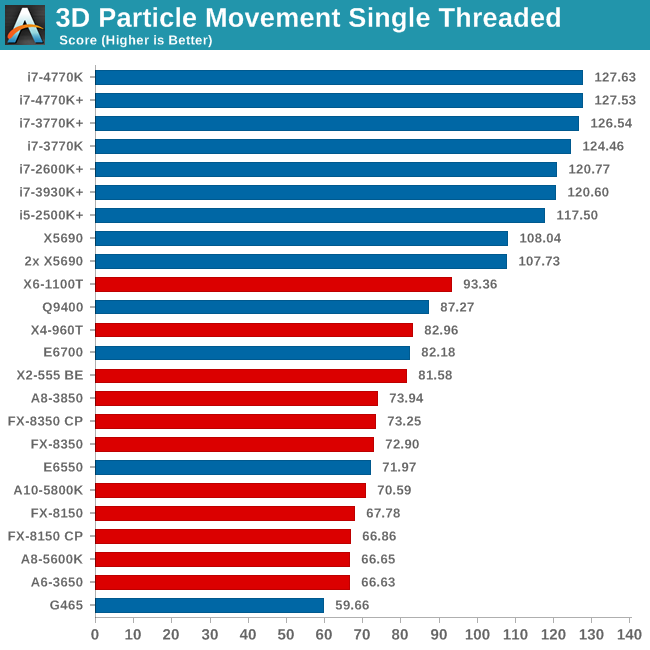
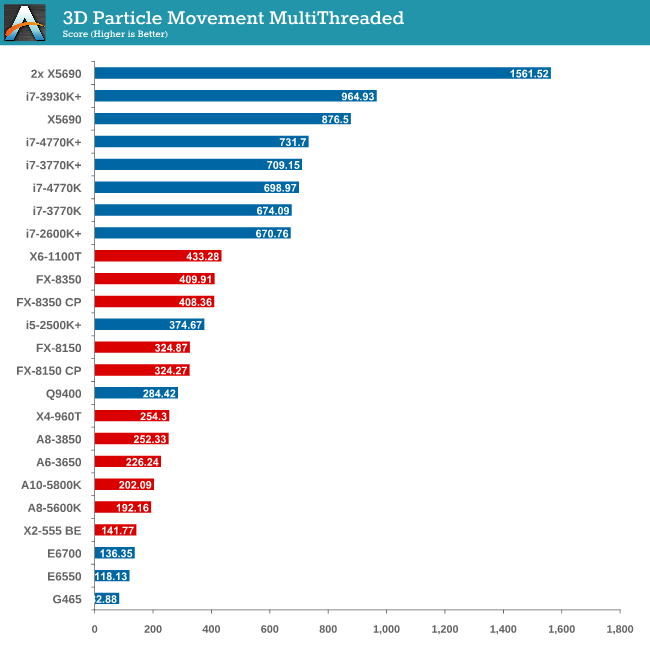
As mentioned in previous reviews, this benchmark is written how most people would tackle the situation – using floating point numbers. This is also where Intel excels, compared to AMD’s decision to move more towards INT ops (such as hashing), which is typically linked to optimized code or normal OS behavior.
The 4770K comes in top in single threaded performance, showcasing the IPC gains of the new architecture. This is also shown in multithreaded tests with MCT both off and on.
Compression - WinRAR x64 3.93 + WinRAR 4.2
With 64-bit WinRAR, we compress the set of files used in our motherboard USB speed tests. WinRAR x64 3.93 attempts to use multithreading when possible and provides a good test for when a system has variable threaded load. WinRAR 4.2 does this a lot better! If a system has multiple speeds to invoke at different loading, the switching between those speeds will determine how well the system will do.
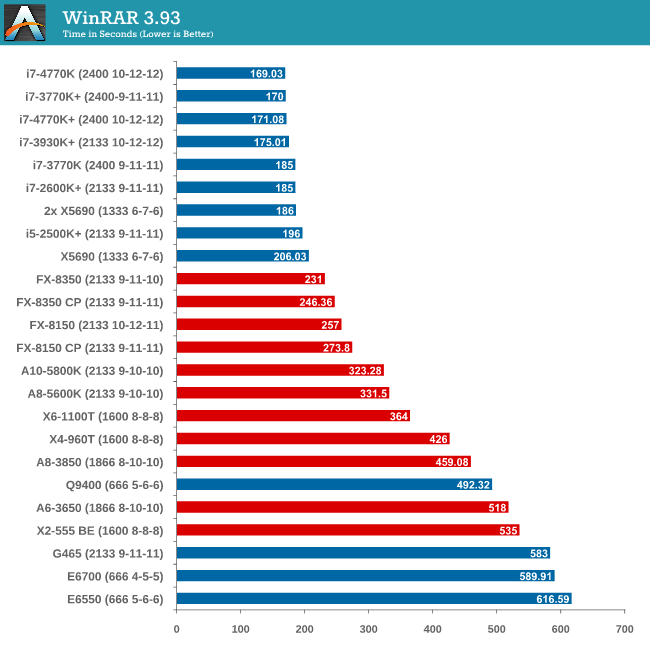
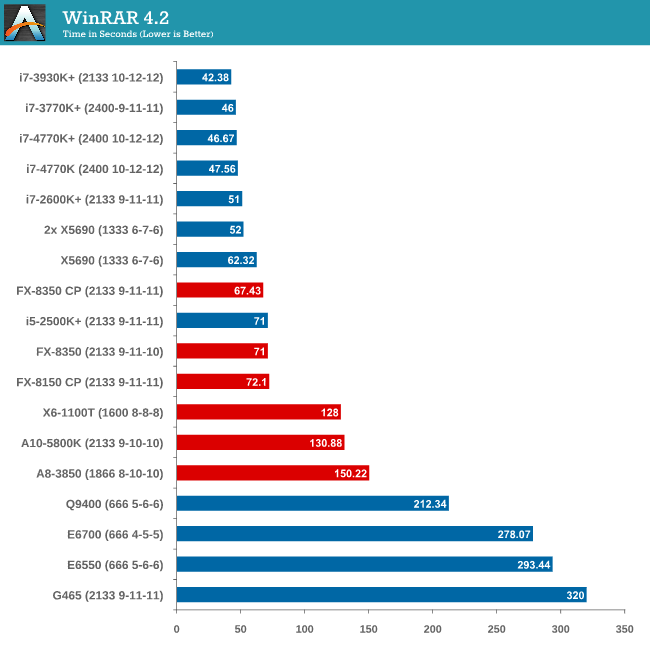
Due to the late inclusion of 4.2, our results list for it is a little smaller than I would have hoped. But it is interesting to note that with the Core Parking updates, an FX-8350 overtakes an i5-2500K with MCT.
Image Manipulation - FastStone Image Viewer 4.2
FastStone Image Viewer is a free piece of software I have been using for quite a few years now. It allows quick viewing of flat images, as well as resizing, changing color depth, adding simple text or simple filters. It also has a bulk image conversion tool, which we use here. The software currently operates only in single-thread mode, which should change in later versions of the software. For this test, we convert a series of 170 files, of various resolutions, dimensions and types (of a total size of 163MB), all to the .gif format of 640x480 dimensions.
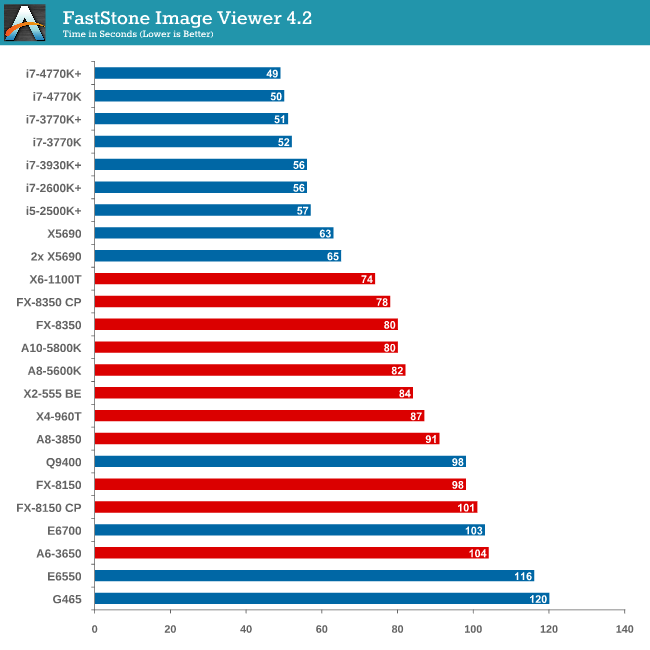
In terms of pure single thread speed, it is worth noting the X6-1100T is leading the AMD pack, and the 4770K takes the top spot. .
Video Conversion - Xilisoft Video Converter 7
With XVC, users can convert any type of normal video to any compatible format for smartphones, tablets and other devices. By default, it uses all available threads on the system, and in the presence of appropriate graphics cards, can utilize CUDA for NVIDIA GPUs as well as AMD WinAPP for AMD GPUs. For this test, we use a set of 33 HD videos, each lasting 30 seconds, and convert them from 1080p to an iPod H.264 video format using just the CPU. The time taken to convert these videos gives us our result.
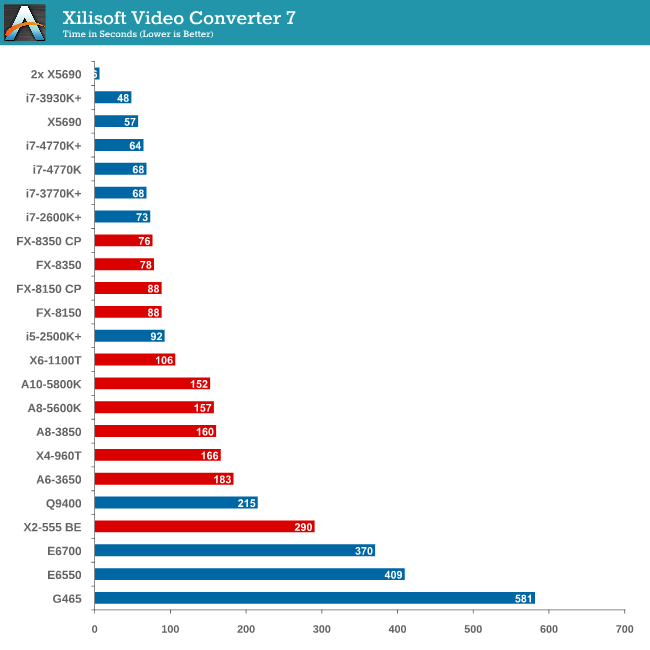
XVC is a little odd in how it arranges its multicore processing. For our set of 33 videos, it will arrange them in batches of threads – so if we take the 8 thread FX-8350, it will arrange the videos into 4 batches of 8, and then a fifth batch of one. That final batch will only have one thread assigned to it (!), and will not get a full 8 threads worth of power. This is also why the 2x X5690 finishes in 6 seconds but the normal X5690 takes longer – you would expect a halving of time moving to two CPUs but XVC arranges the batches such that there is always one at the end that only gets a single thread.
Rendering – PovRay 3.7
The Persistence of Vision RayTracer, or PovRay, is a freeware package for as the name suggests, ray tracing. It is a pure renderer, rather than modeling software, but the latest beta version contains a handy benchmark for stressing all processing threads on a platform. We have been using this test in motherboard reviews to test memory stability at various CPU speeds to good effect – if it passes the test, the IMC in the CPU is stable for a given CPU speed. As a CPU test, it runs for approximately 2-3 minutes on high end platforms.
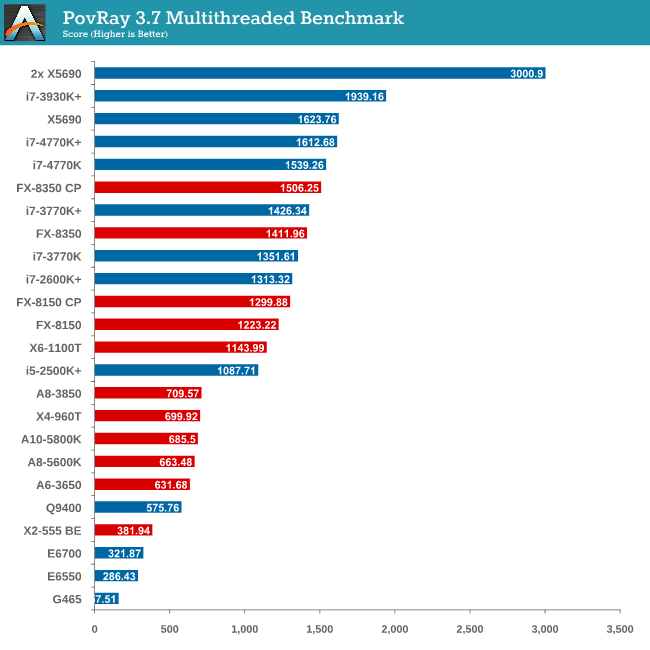
The SMP engine in PovRay is not perfect, though scaling up in CPUs gives almost a 2x effect. The results from this test are great – here we see an FX-8350 CPU below an i7-3770K (with MCT), until the Core Parking updates are applied, meaning the FX-8350 performs better! The 4770K also has a chance to flex its compute muscles, performing almost as well as the 8-core Westmere CPU.
Video Conversion - x264 HD Benchmark
The x264 HD Benchmark uses a common HD encoding tool to process an HD MPEG2 source at 1280x720 at 3963 Kbps. This test represents a standardized result which can be compared across other reviews, and is dependent on both CPU power and memory speed. The benchmark performs a 2-pass encode, and the results shown are the average of each pass performed four times.
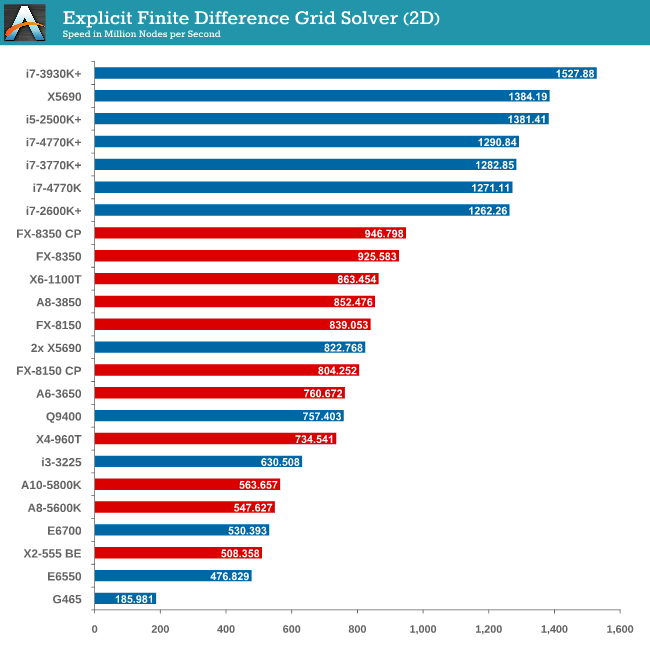
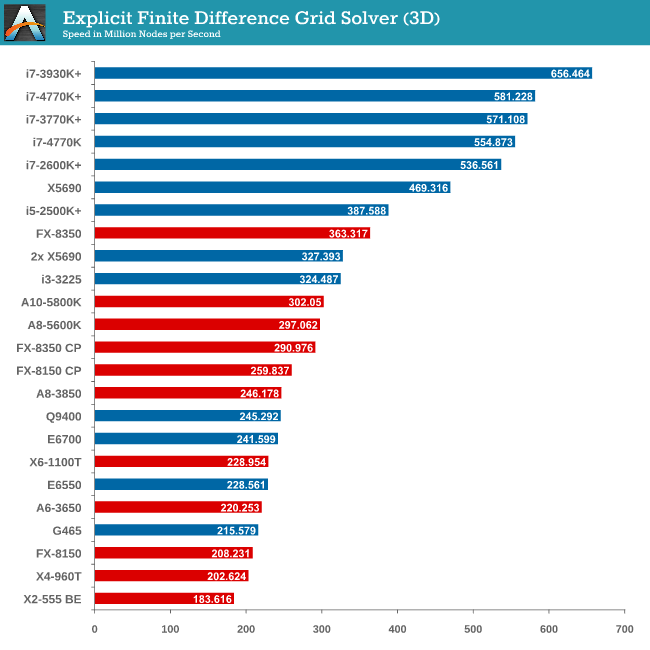
Grid Solvers - Explicit Finite Difference
For any grid of regular nodes, the simplest way to calculate the next time step is to use the values of those around it. This makes for easy mathematics and parallel simulation, as each node calculated is only dependent on the previous time step, not the nodes around it on the current calculated time step. By choosing a regular grid, we reduce the levels of memory access required for irregular grids. We test both 2D and 3D explicit finite difference simulations with 2n nodes in each dimension, using OpenMP as the threading operator in single precision. The grid is isotropic and the boundary conditions are sinks. Values are floating point, with memory cache sizes and speeds playing a part in the overall score.
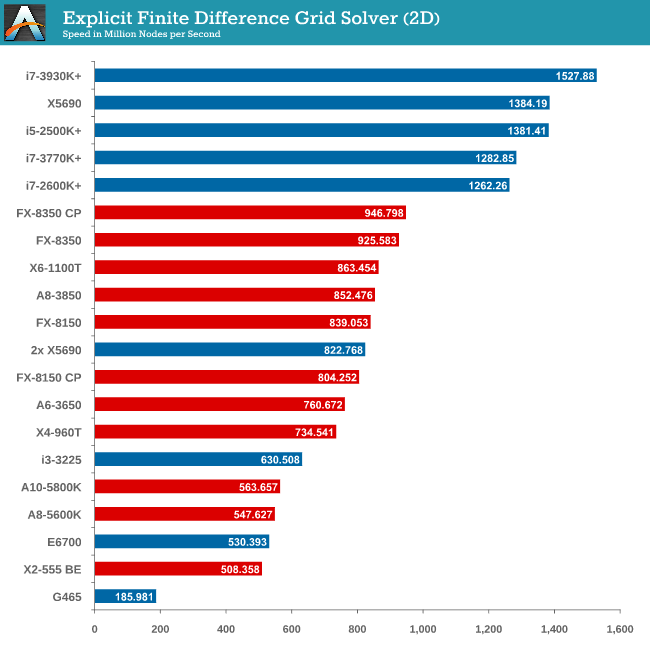
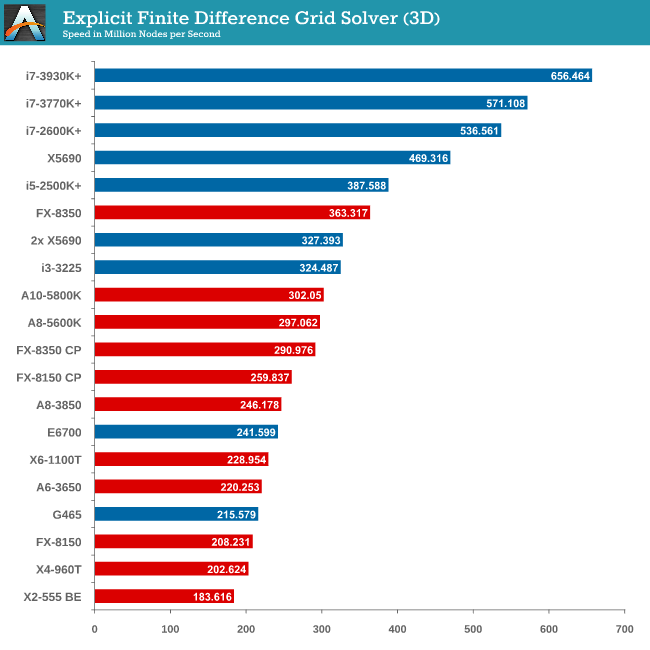
Grid solvers do love a fast processor and plenty of cache in order to store data. When moving up to 3D, it is harder to keep that data within the CPU and spending extra time coding in batches can help throughput. Our simulation takes a very naïve approach in code, using simple operations.
Grid Solvers - Implicit Finite Difference + Alternating Direction Implicit Method
The implicit method takes a different approach to the explicit method – instead of considering one unknown in the new time step to be calculated from known elements in the previous time step, we consider that an old point can influence several new points by way of simultaneous equations. This adds to the complexity of the simulation – the grid of nodes is solved as a series of rows and columns rather than points, reducing the parallel nature of the simulation by a dimension and drastically increasing the memory requirements of each thread. The upside, as noted above, is the less stringent stability rules related to time steps and grid spacing. For this we simulate a 2D grid of 2n nodes in each dimension, using OpenMP in single precision. Again our grid is isotropic with the boundaries acting as sinks. Values are floating point, with memory cache sizes and speeds playing a part in the overall score.
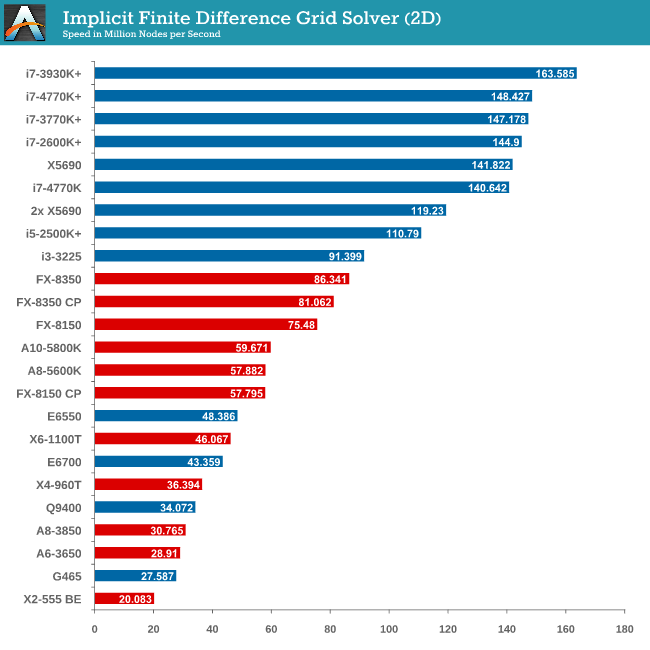
2D Implicit is harsher than an Explicit calculation – each thread needs more a lot memory, which only ever grows as the size of the simulation increases.
Point Calculations - n-Body Simulation
When a series of heavy mass elements are in space, they interact with each other through the force of gravity. Thus when a star cluster forms, the interaction of every large mass with every other large mass defines the speed at which these elements approach each other. When dealing with millions and billions of stars on such a large scale, the movement of each of these stars can be simulated through the physical theorems that describe the interactions. The benchmark detects whether the processor is SSE2 or SSE4 capable, and implements the relative code. We run a simulation of 10240 particles of equal mass - the output for this code is in terms of GFLOPs, and the result recorded was the peak GFLOPs value.
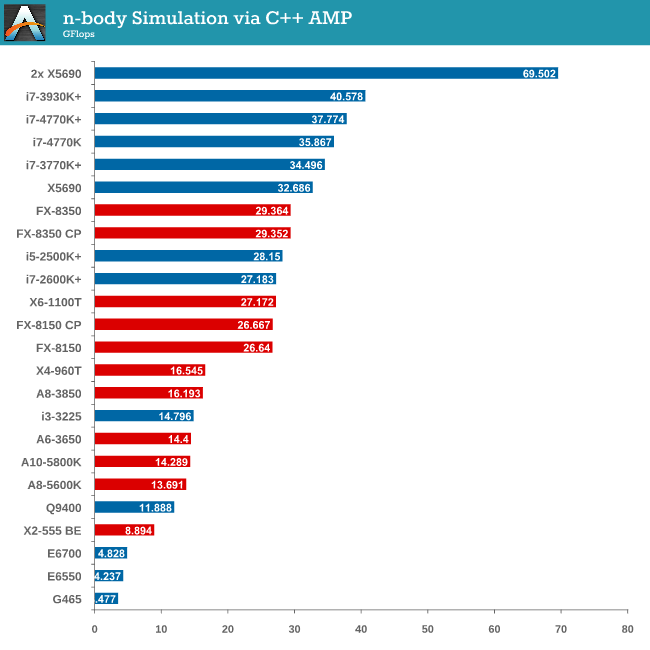
As we only look at base/SSE2/SSE4 depending on the processor (auto-detection), we don’t see full AVX numbers in terms of FLOPs.










116 Comments
View All Comments
yougotkicked - Tuesday, June 4, 2013 - link
this sounds quite interesting, though I wonder if the AI is runtime bound rather than solution bound, as this could make the testing somewhat nondeterministic.To clarify what I mean; a common method in AI programming is to let algorithms continue searching for better and better solution, interrupting the algorithm when a time limit has passed and taking the best solution it has found so far. Such approaches can result in inconsistent gameplay when pitting multiple AI units against each other, which may change the game state too much between trials to serve as a good testing platform.
Even if the AI does use this approach it may not bias the results enough to matter, so I guess the only way to be sure is to run the tests a few times and see how consistent the results are on a single test system.
Zoeff - Tuesday, June 4, 2013 - link
Forget about SupCom2 - That game has been scaled down quite a bit compared to SupCom1 and isn't as demanding to CPUs. There's also an active SupCom1 community that has and still is pushing out community made patches. :-)SupCom actually has a build-in benchmark that plays a scripted map with some fancy camera work. Anyone can launch this by adding "/map perftest" to your shortcut. That said, it doesn't seem to be working properly anymore after several patches nor does it actually give any useful data as the sim score is capped at 10k for today's CPUs. And yet it's extremely easy to cripple any CPU you throw at it when simply playing the game. Just open up an 81x81km map with 7 AI enemies and watch your computer slow to a crawl as the map starts filling up.
And yes, the AI is "solution bound". Replays of recorded games with AI in them wouldn't work otherwise.
I wonder if somebody could create a custom SupCom1 benchmark... *Hint Hint*
FBB - Tuesday, June 4, 2013 - link
They've had over 5 million concurrent online users. The total number will be much higher.DanNeely - Tuesday, June 4, 2013 - link
What exactly does Steam count as online? Does just having the client sit in my tray count; or do I need to be playing a steam game at the time to be counted?wicko - Tuesday, June 4, 2013 - link
Definitely just signed in: 823,220 Players In-Game | 4,309,324 Players OnlineSource: http://steamcommunity.com/
chizow - Tuesday, June 4, 2013 - link
Thanks for the tests, there's a lot of data points in there so that's always appreciated.I would've liked to have seen some higher perf Nvidia solutions in there though, at the very least some Kepler parts. It looks like a lot of the higher end Intel parts hit a GPU bottleneck at the top, which is not unexpected at 1440p with last-gen Fermi parts.
What it does show for sure is, you may give pause to going beyond 2-way CF/SLI if you have to go lower than x8 on that 3rd slot. Which means you will probably have to shell out for one of the pricier boards. Hard not to recommend X79 at this point for 3-way or higher, although the lack of official PCIe 3.0 support was a red flag for me.
I went with the Gigabyte Z87x UD4 because I don't ever intend to go beyond 2-way SLI and the 3rd slot being x4 (2.0) was better than the x8/x4/x4 (3.0) config on most boards, which gives me the option to run a PhsyX card and retain x8/x8 (3.0) for my two main cards.
Gunbuster - Tuesday, June 4, 2013 - link
So I'll stick with my 2600K @4.5ghz and continue to ponder what new Korean 27" LCD to get. Tech is pretty boring at the moment.wicko - Tuesday, June 4, 2013 - link
I haven't bothered overclocking my 2600K and I still feel it's plenty powerful. I think I may get a second GTX 670 though, Metro Last Light doesn't run all that great at 2560x1440.kallogan - Tuesday, June 4, 2013 - link
Haswell, haswell, haswell. Making one paper per day about it will not make it better. Boring cpu gen. Wake me up when something interesting shows up.chizow - Tuesday, June 4, 2013 - link
So I guess the solution is to just ignore the launch to placate all those who have no interest in the launch, rather than post reviews and info about it for the ones that actually do? Doesn't make a lot of sense.If it doesn't interest you, move along.